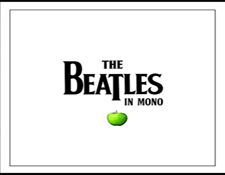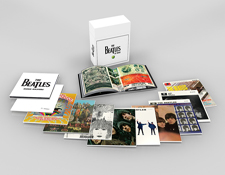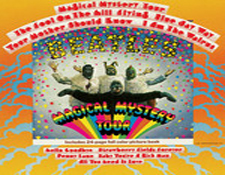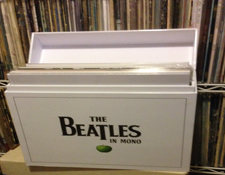It’s the time of year for saving money!
I have to start this review with a round of heartfelt applause for the folks at Capitol/EMI/Universal for going the extra mile to make sure this boxed set of original Monaural recordings by The Beatles was done right this time around. They tipped their hat back when the Mono box came out on CD several years back, as that was a significantly better package — and listening experience — than the Stereo counterpart they issued at that time.
 The Mono CD box went to great lengths to recreate the look and feel of the original releases right down to the special folded-over construction of the covers (which is how they were in the UK back in the day). More importantly, they offered up an uncompressed presentation of the audio on the CDs — that is, the master tapes used did not have the additional compression necessitated for keeping the grooves from getting too wide range (which playback devices of the day would have otherwise have trouble tracking). That box set sounded pretty remarkable, especially since it was on CD after all (which inherently forces all music to be chopped down to 16 bits and all that). That said, the stage was set pretty high for this LP equivalent three years down the road — we expected equal or better treatment still for the Mono vinyl reissues.
The Mono CD box went to great lengths to recreate the look and feel of the original releases right down to the special folded-over construction of the covers (which is how they were in the UK back in the day). More importantly, they offered up an uncompressed presentation of the audio on the CDs — that is, the master tapes used did not have the additional compression necessitated for keeping the grooves from getting too wide range (which playback devices of the day would have otherwise have trouble tracking). That box set sounded pretty remarkable, especially since it was on CD after all (which inherently forces all music to be chopped down to 16 bits and all that). That said, the stage was set pretty high for this LP equivalent three years down the road — we expected equal or better treatment still for the Mono vinyl reissues.
I’m sure they heard some of the fan and audiophile complaints over the manner in which the Stereo LP set was created — I didn’t even bother buying any of those due to all the negative stuff I was hearing from friends and reading about online. I decided to skip that wave hoping for better things with the Mono set.
Thankfully, the powers that be listened to the fans and have done it up right, giving us — the ones who are likely to buy these kinds of things — pretty much exactly what we wanted with fairly exacting accuracy. They have been very smart, alerting fans to the differences up front, so there are no surprises (so really, there is thus no room for any real griping folks!). For example, the insert with Sgt. Pepper details that “the packaging of this album replicates, as closely as possible, the artwork and construction of the original LP released in June 1967. Some of the copyright information has changed since then. The revised information is listed here and on the labels of the disc.”
That is so totally honest and fair, it diffuses any need for any of us to really grump. Smart move!
 To their point, indeed if you compare this new Sgt. Pepper to the original copies the cover is slightly different in that it does not have the sort of laminated plastic covering that made it nice and shiny back in the day — these new ones are no less shiny, but they are made of a more contemporary oaktag type cardboard and the printing process was probably different as well, so there was no need for the laminated sheen. The only thing missing is that they did not reproduce all of the early period-accurate inner sleeves (as they charmingly did on the Mono CD set).You do get the red Sgt. Pepper one and the black sleeves for The White Album.
To their point, indeed if you compare this new Sgt. Pepper to the original copies the cover is slightly different in that it does not have the sort of laminated plastic covering that made it nice and shiny back in the day — these new ones are no less shiny, but they are made of a more contemporary oaktag type cardboard and the printing process was probably different as well, so there was no need for the laminated sheen. The only thing missing is that they did not reproduce all of the early period-accurate inner sleeves (as they charmingly did on the Mono CD set).You do get the red Sgt. Pepper one and the black sleeves for The White Album.
(This is as far as I suspect I’ll be going on in the splitting hairs department, folks).
Anyhow, enough about cosmetics. Lets look at how this thing sounds….
Before I unpacked my box set I put on one of my original UK pressings of Sgt. Pepper to refresh my memory because that is where I planned to start my listening experience — smack dab in the middle of The Beatles ascension to legend. Now, my copy of that LP always sounded pretty great, especially for a pressing manufactured about 40 years ago which has seen a fair amount of play over the years.
Happily, the new LP of Sgt. Pepper in Mono sounds pretty much just like the original only a bit better, if that is possible.
Well, first off the new pressings are dead quiet and perfectly centered. Absolutely silent entry to the music, which just jumps out of the speakers.
Let us consider another bit of information given to us in the insert card regarding the mastering of this album
“This album was cut for vinyl from the original master tapes by using a completely analogue signal path and with constant reference to the notes made by the cutting engineer for the first pressing of the LP. It has been made with current technology and without imposing the restrictions necessitated by the limitations of record plays in the 1960s. Consequently this version reveals more of the content of the audio on the master tapes.”
Indeed, I have to admit I am hearing details with a sense of clarity I have never quite heard before from this Mono Pepper, such as the spoken comments just as the Sgt. Pepper reprise kicks in. The Indian percussion and instrumentation on George Harrison’s “Within You Without You” is spectacular.
]]> One of the hallmarks of the mono mixes has always been the fact that the rhythm section sounds tighter, more cohesive and fuller, mixed neatly together dead center. The resultant sound includes punchier drums and fatter, more precise bass reproduction. Sgt. Pepper in Mono was the mix that the Beatles themselves worked hard on while the stereo mix was handled (quite well, mind you) by a then assistant engineer who went on to greater things. Aside from having a pristine mint never played original pressing, this is probably the best you and I will get to hear this album sound.
One of the hallmarks of the mono mixes has always been the fact that the rhythm section sounds tighter, more cohesive and fuller, mixed neatly together dead center. The resultant sound includes punchier drums and fatter, more precise bass reproduction. Sgt. Pepper in Mono was the mix that the Beatles themselves worked hard on while the stereo mix was handled (quite well, mind you) by a then assistant engineer who went on to greater things. Aside from having a pristine mint never played original pressing, this is probably the best you and I will get to hear this album sound.
It sounds pretty fabulous!
Ok, next up I am jumping to the first Beatle record that I ever bought with my own money: Magical Mystery Tour. This album is a curious one in the set in that it was created primarily for the U.S. marketplace, expanding the double EP concept issued in the UK with other singles and B-sides from the period. As it turned out it made for a fine follow up release to Sgt. Pepper and eventually was issued in Europe in this format. However, I have never, ever, heard this album sound this good, even from the original Mono US pressings I’ve long owned. There is so much more dynamic range and detail on this pressing, it is astounding. “I Am The Walrus” rocks so gorgeously, with the cellos jumping out of the speakers while Ringo’s propulsive drumming pushes the whole thing along into infinity. Fascinatingly, I’m reminded that some of the distortion I’ve always heard on my LP pressings is indeed part of the sound of John Lennon’s tape-saturated vocals.
Oh, did I mention that the vinyl is dead quiet and perfectly centered?
Once again, there is some very interesting information to consider regarding Magical Mystery Tour presented in the insert card with the Beatles in Mono box set:
 “Because Magical Mystery Tour was not released as a British LP in 1967, it was necessary to create a new master using the original mono tapes for the EP release and the singles included on the second side of the albums. To avoid risk of damaging the masters by removing tracks from their original reels and then returning them, the original tapes were copied to a new cutting master created for this release.”
“Because Magical Mystery Tour was not released as a British LP in 1967, it was necessary to create a new master using the original mono tapes for the EP release and the singles included on the second side of the albums. To avoid risk of damaging the masters by removing tracks from their original reels and then returning them, the original tapes were copied to a new cutting master created for this release.”
So in effect what the producers are saying, assuming they remained true to their all analog signal path approach, is that what you are hearing here is a first generation copy off the master tapes. That makes sense and it still is better than anything we have heard before considering that the original Mono mixes were on a tightly packed 7-inch EP and that the version used for making the original US LP was probably at least two generations removed from the master tapes, if not more. Thus this recording is probably as definitive as we are to get in the analogue realm (until the time when we get a super high resolution digital copy all in first generation quality — but even then there will be sonic trade offs). For now, I am very pleased as this is sounding spectacular.
Oh, and the cover art is of a very very high quality, equal to and in some ways surpassing the original pressings.
Taking a step backwards, I put on Help! and was a little surprised at what I heard. Of of all the albums played thus far, it was the first one to cause some pause. It sounded somehow muted.
I had to go back to compare, cherry picking tracks on my probably-early-80s-or-late-70s Mono UK pressing and also then go to the Mono box CD to see if I possibly was hearing a problem. It is not bad but it is a different sound than I was accustomed to. My old UK pressing is a lot brighter sounding, perhaps unnaturally so in contrast. Take a track like “Ticket to Ride,” for example, which on the new one appears a bit subdued at first listen. However, when you listen closely and turn up the volume a tad on your amplifier, the warmth of the mix approach begins to take hold in your mind’s eye (if you will). I had to adjust my expectations of what I was accustomed to hearing.
 Acclimated to it, the new mastering indeed seems more balanced, with fuller, rounder bass and more natural sounding highs. There are lots of mid-ranges in the more acoustic flavored tracks so I suspect that impacted the sound a great deal. This album arguably signaled the first major changes in The Beatles musical direction sound wise, so there is much more emphasis on acoustic guitars and the 12-string jangle of George Harrison’s Rickenbacker guitar for them to deal with in the mixes. 12-string guitar is not an easy sound to capture and blend in with other instruments!
Acclimated to it, the new mastering indeed seems more balanced, with fuller, rounder bass and more natural sounding highs. There are lots of mid-ranges in the more acoustic flavored tracks so I suspect that impacted the sound a great deal. This album arguably signaled the first major changes in The Beatles musical direction sound wise, so there is much more emphasis on acoustic guitars and the 12-string jangle of George Harrison’s Rickenbacker guitar for them to deal with in the mixes. 12-string guitar is not an easy sound to capture and blend in with other instruments!
Curiously, I also notice that this flavor on the mix occurs mostly on the first side which features songs recorded for the movie, so perhaps the sound we are hearing is simply that sound they recorded in that week before the band flew off to the Bahamas to make the actual movie… They were working at a dizzying pace, for sure!
But by the time you get to side two, we find ourselves in more sparkly sounding territory, albeit with an overall a more mature tonality. Gotta say, programming wise, the choice to follow a track like “Yesterday” with “Dizzy Miss Lizzy” on this album still baffles me. It also underscores the somewhat hodgepodge nature of this collection (which, again, may have contributed to the sonic variations).
Anyhow…
Jumping back to the beginning, I put on the first Beatles album, Please Please Me, for a bit of ear cleansing after the increased density of sound on the former albums. I am impressed with how clean and punchy it sounds! Really, there is almost a three dimensional presence to this recording which sounds better than any pressing I’ve had the good fortune of owning. Also this is another instance where the producers explain that they had to take the master tape down one generation to make a new analogue production master as the originals were at risk of being damaged due to their age.
Nonetheless, this version has a presence and punch that belies its simplistic (essentially) live-to-tape recording process (the whole album was recorded for the most part in one 13 hour session!). That freshness jumps out of the grooves and through your speakers — this is the sound of a band playing their live set in one of the greatest studios in the world and its all quite perfect and still exciting in that way.
Oh, by the way, did I mention that the vinyl is dead quiet and perfectly centered?
One of the neat things about this pressing is that they reproduce the original gold color typeface Parlophone Records label that was used in 1963 when the album first came out — this is one of those “holy grail” type albums which most of us collector types never get to see or hear because they are so rare (and when you do see them, they are madly expensive!). So now you can have a solid well made reproduction that is more than “just” a copy. This is a bonafide well made pressing that rivals the originals (if you could find one that was unplayed from 1963, that is!).
Ok, time to let my ears rest a bit before diving into the rest of the collection and Part II. More Fab Four fun to come!
One of Mark Smotroff’s earliest memories at just three years old was seeing The Beatles on the Ed Sullivan (TV) show. His first record bought with his own savings at age five was The Beatles’ She Loves You (on Swan Records). A lifelong Beatle fanatic, Mark is also a freelance writer and avid music collector who has worked for many years in marketing communications for the consumer electronics, pro audio and video games industries, serving clients including DTS, Sega, Sony, Sharp, AT&T and many others. www.smotroff.com Mark has written for EQ Magazine, Mix Magazine, Goldmine/DISCoveries Magazine, BigPictureBigSound.com, Sound+Vision Magazine and HomeTechTell.com. He is also a musician / composer whose songs have been used in TV shows such as Smallville and Men In Trees as well as films and documentaries. www.ingdom.com Mark is currently rolling out a new musical he’s written: www.dialthemusical.com.






